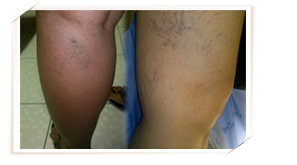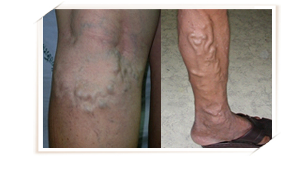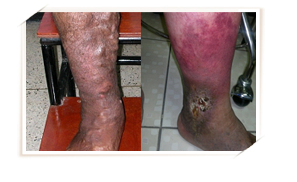About Abnormal Veins
Types of Veins Abnormal, dilated veins appearing on the legs affect 50% of the population during their lifetime. There are three common types, which are frequently seen in combination.

- Spider veins are the finest and are usually fed by larger ‘reticular veins’, which are larger bluish veins under the skin
- Varicose veins are the largest; they often bulge above the skin
surface and are normally due to a weakness in the vein wall (Figure 2).
Symptoms associated with varicose veins include heaviness, burning,
aching, stinging, throbbing, swollen ankles, restless legs and leg cramps.
The presence of a skin rash, small blue veins on the feet, skin
discolouration, ulcers, and scarring and indicates the presence of
increasing vein pressure which is likely to get worse if not treated.
Treating the abnormal veins will significantly improve symptoms for
the majority of patients.


- Chronic wounds from venous insufficiency.It is a late stage of a condition where blood pools in the veins, causing fluid to leak out and lead to the development of chronic wounds that do not heal despite treatment. It is important to seek the expertise of a specialist to address the underlying cause before it progresses and becomes a potential site for infection, tissue damage, or even skin cancer on the affected leg.
Why do abnormal veins develop?
A definitive cause is not known, however a strong family history suggests that some people inherit veins that are
more likely to deteriorate. In women, oestrogen may play a role as the onset of puberty and pregnancy and taking
the oral contraceptive can give rise to vein abnormalities. In pregnancy, the enlarged uterus can restrict blood flow
from the legs and promote the development of varicose veins. Spider veins and varicose veins are also associated
with obesity. Occupations involving prolonged standing tend to increase the likelihood of veins to develop. Bone
fractures and soft tissue trauma can cause localized vein abnormalities.

Why is the mechanism by which veins develop?
Blood in leg veins normally travels upwards to the heart. Due to
gravity blood tries to flow back down towards the feet. However,
normal veins have valves, which close to prevent abnormal flow
towards the feet. It is the breakdown of the valves that leads to
abnormal flow, which in turn leads to increased pressure in the vein.
The increased pressure eventually causes the vein wall to expand
and bulge producing a varicose vein.
Varicose veins serve no useful function to the body’s circulation.
Our body has the ability to establish alternative pathways to bypass
the abnormal varicose veins. When varicose veins are closed down
the circulatory system improves, as do many of the symptoms. It is
important to understand that varicose veins can be a progressive
condition and that totally new veins can develop with time. Maintenance
treatment is likely for most patients.
Can vein oriblems be prevented?
If you are prone to vein problems, it is advisable to pursue a healthy diet and lifestyle, to maintain normal weight
and exercise regularly to minimize the likelihood of further problems. Wearing specialized venous support stockings
may ease symptoms and slow the progression of abnormal veins; however practically speaking no specific
preventative treatment exists. By the way crossing your legs does not cause varicose veins.
